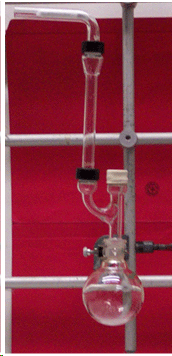
Last updated
1. General
Review the following topics: recrystallization theory, vacuum filtration, GC chromatography
DO NOT DISCARD ANYTHING INTO THE WASTE CONTAINER BEFORE YOU ISOLATED YOUR FINAL PRODUCT.
2. Experiment
a. Due to the high sensitivity of the Grignard reagent towards water, it is very important that all glassware used in the reaction is thoroughly dried (this means the very least that there are no visible water droplets!). All bottles have to be kept closed if not in use to reduce the amount of water in the solvents and reagents.
b. Solutions of MeMgBr are potentially pyrophoric! Thus, the solution will be dispensed by the teaching assistant.
c. Diethyl ether, tetrahydrofuran and petroleum ether are flammable. Sulfuric acid (10 %) is very corrosive.
While the lab support usually passes out two-necked or three-necked flasks for the reaction, they occassionally run out of them. In those cases, the setup does not contain a Claisen adapter (╚╣-piece). However, if you receive a round-bottomed flask, the setup should look like this:

The round-bottomed flask has to be clamped at the neck and not at the bulb part!
The rubber septum has to be folded over in order to provide a good seal. Just placing them loosely on the top will not do the same job.
The drying agent used in the lab is granularCaCl2. Powders cannot be used because they are going to clog up the drying tube entirely after a proper packing. The drying agent has to be properly sandwiched between two cotton plugs. Make sure to push the outer cotton plug in as far as possible so that any air going into the setup has to pass the drying agent.
About 12 mmol of Grignard reagent are needed for the reaction. The entire setup should be assembled before the TA dispenses the reagent with the syringe. The lab support will provide a 3.0 M solution of MeMgBr in diethyl ether this quarter.
Benzoin is dissolved in 10 mL of THF. The Erlenmeyer flask has to be kept closed during the dissolution process to minimize the uptake of water!
The flask has to be placed in an ice-bath while the benzoin solution is added. In addition, the reaction mixture has to be stirred well during the addition.
During the work-up, the 10 % sulfuric acid solution has to be added slowly especially in the beginning. Why?
After the organic and the aqueous layer are separated the first time (be careful here!), the aqueous layer has to be extracted with diethyl ether again. Why?
The combined organic layers are extracted with sodium bicarbonate solution Why?
The drying step should employ the minimum quantity of anhydrous MgSO4. Why?
In most cases, two recrystallizations will be required in order to get a relatively pure compound. In rare cases, one recrystallization will be enough to remove the unreacted benzoin. Do not to place the solution in an ice bath. What are you trying to remove at this point? How do you know if you are done purifying the sample?
Submit two GC samples (~1-2 mg/mL) for evaluation. (The samples should not contain any visible amounts of water since this will ruin the column and the separation will be rather poor as well.) One from the crude product (after the workup before starting the recrystallization) and a second one once you isolated your final product in order to evaluate its purity. The bar code number has to be recorded. Sign in your name and the vial numbers in the list that the TA provides. The spectra can be picked up from the instructors office usually in the afternoon of the following day.
3. Things to think about
a. Which compounds can be found in the crude product? Which consequences does this have for the purification?
b. Why are 1,2-dibromides poor reactants to producer Grignard reagents?
c. Why is it important to minimize the amount of drying agent used in this experiment?
d. How many signals do you expect to see for the product in the 1H and 13C-NMR spectrum?
e. Why is the description of a Grignard reagent as "RMgX" strictly speaking not correct?
f. Why are ethers most commonly used for Grignard reactions?
g. What are alkyl iodides very good substrates for the formation of Grignard reagents while alkyl fluorides are hardly used for this purpose?